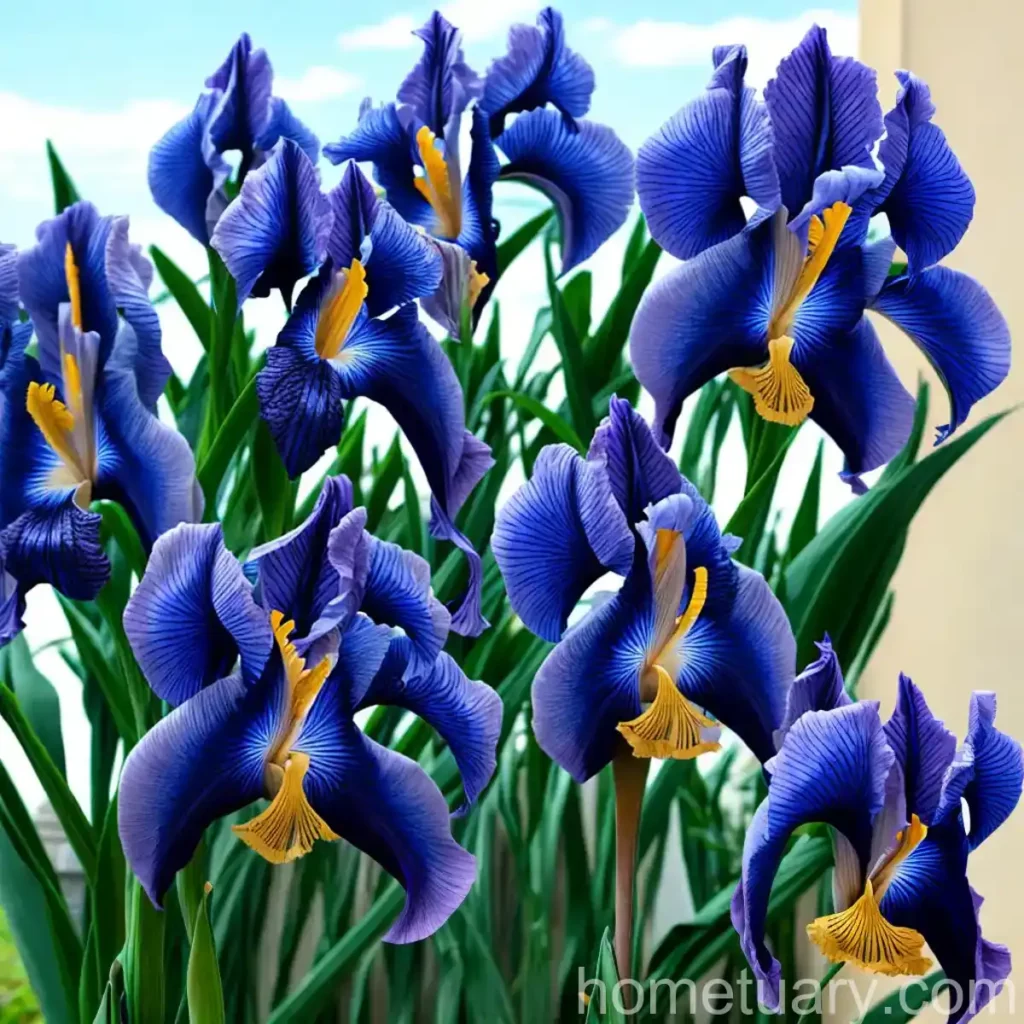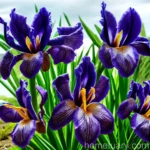Southern Blue Flag (Iris virginica): A Comprehensive Guide
Iris virginica, also known as the Southern Blue Flag, is a perennial plant that is native to the wetlands and swamps of North America. This stunning iris species is known for its vibrant, blue flowers and its ability to thrive in aquatic environments, making it an attractive choice for gardeners and landscapers seeking to add color and interest to water features and moist garden areas. In this guide, we will explore the various aspects of the Southern Blue Flag, including its culture, uses, maintenance, and more.
What is the Southern Blue Flag (Iris virginica)?
Iris virginica, commonly referred to as the Southern Blue Flag, is a member of the Iris genus within the Iridaceae family. This species is characterized by its sword-shaped leaves and striking blue or violet flowers, which bloom in the spring and early summer. The species name “virginica” alludes to its presence in the state of Virginia, where it was first documented.
Key Takeaways
Before delving into the specifics of the Southern Blue Flag, let’s take a moment to highlight the key takeaways about this fascinating plant.
- Scientific Name: Iris virginica
- Common Name: Southern Blue Flag
- Family: Iridaceae
- Genus: Iris
- Plant Type: Perennial
- Native Habitat: Wetlands and swamps of North America
- Flower Color: Blue or violet
- Bloom Time: Spring to early summer
- Special Features: Thrives in aquatic environments
Now, let’s explore the various aspects of this captivating plant in more detail.
Culture
Understanding the cultural requirements of the Southern Blue Flag is essential for successfully cultivating and maintaining this species. From water and sunlight needs to soil preferences, these factors play a crucial role in the overall health and vigor of Iris virginica.
Water
Being native to wetland environments, the Southern Blue Flag thrives in consistently moist to wet soil. In a garden setting, it is important to ensure that the plant receives an adequate water supply, especially during dry periods or in regions with limited rainfall. A good approach is to mimic natural wetland conditions, either by planting it in a water feature with shallow standing water or ensuring that the soil around it remains consistently moist.
Sunlight
In terms of sunlight requirements, the Southern Blue Flag performs best in partial to full sun. While it can tolerate some shade, providing ample sunlight will encourage robust growth and prolific flowering. When selecting a planting location, opt for a spot that receives at least 6 hours of direct sunlight daily.
Fertilizer
When it comes to fertilization, Iris virginica generally does not have high nutrient requirements. However, if the soil is particularly poor or lacks organic matter, amending it with a balanced, slow-release fertilizer during the growing season can promote healthy growth and blooming. Additionally, a top dressing of compost or well-rotted manure in the spring can provide a gentle nutrient boost for the plant.
Soil
The ideal growing medium for the Southern Blue Flag is rich, moist soil with good drainage. Given its natural habitat in wetlands and swamps, it is well-adapted to soils with higher organic content and does not tolerate dry or compacted soils well. To improve soil structure and fertility, incorporate organic matter such as compost or peat when planting and during periodic soil amendments.
Pruning
Iris virginica generally requires minimal pruning. However, removing spent flower stems and old foliage after the blooming period can help maintain the plant’s vigor and aesthetic appeal. Additionally, if the plant becomes overcrowded, dividing the rhizomes every few years can rejuvenate the Southern Blue Flag and prevent it from becoming overly dense.
Propagation
Propagation of the Southern Blue Flag can be accomplished through various methods, including seed sowing and rhizome division. Both approaches have their own set of advantages and considerations.
Seed Propagation
While Southern Blue Flag seeds can be collected from spent flower pods, it is important to note that this method of propagation requires patience, as the seeds can take several years to mature into flowering plants. To sow iris virginica seeds, follow these basic steps:
- Harvest mature seeds in late summer or early fall.
- Prepare a seedbed with well-draining soil and amend with compost.
- Sow the seeds at a shallow depth, approximately 1/4 inch, and lightly cover them with soil.
- Keep the seedbed consistently moist until germination occurs, typically within a few months.
- Transplant the seedlings to their permanent location once they have developed a few sets of true leaves.
Rhizome Division
Dividing the rhizomes of established Southern Blue Flag plants is a more expedient method of propagation that yields mature, flowering plants more rapidly. This approach can also help in rejuvenating crowded clumps and maintaining the health and vigor of the plant. Here’s how to divide Iris virginica rhizomes:
- In early spring, before new growth emerges, carefully dig up the clump of iris virginica.
- Use a sharp, clean knife to separate the rhizomes, ensuring that each division has healthy roots and at least one growth point.
- Trim any damaged or rotting portions from the rhizomes.
- Replant the divisions at the same depth as the parent plant, spaced approximately 12 to 24 inches apart.
Container Popularity
While the Southern Blue Flag is typically associated with aquatic or moist garden settings, it can also be grown in containers provided that the specific water and sunlight requirements are met. This makes it a versatile choice for gardeners with limited space or those seeking to showcase its beauty on patios, decks, or balconies.
Container Uses
When growing Iris virginica in containers, consider placing them in water gardens, large decorative pots, or containers specifically designed for aquatic plants. These containers should be equipped with adequate drainage and filled with a suitable aquatic planting medium to mimic the moist, nutrient-rich conditions that the plant thrives in.
Container Maintenance
In terms of maintenance, container-grown Southern Blue Flag plants require regular watering to keep the planting medium consistently moist. It is important to monitor the water level, especially during hot and dry periods, to prevent the roots from drying out. Additionally, providing ample sunlight and occasionally fertilizing with a balanced, water-soluble fertilizer can support healthy growth and flowering.
Common Diseases
While the Southern Blue Flag is a relatively resilient plant, it can be susceptible to certain diseases and pests. Being aware of these potential issues and knowing how to address them is crucial for maintaining the health and vitality of Iris virginica.
Disease Diagnosis
One of the most common diseases that affect Iris virginica is bacterial leaf blight, which manifests as brown, water-soaked lesions on the foliage. Additionally, fungal leaf spot diseases and root rot can occur in overly wet conditions. To diagnose such diseases, carefully examine the plant for any abnormal symptoms, such as discolored or distorted leaves, and take appropriate measures for treatment.
Disease Prevention and Management
To prevent diseases, it is important to provide adequate air circulation and avoid overhead watering, which can lead to excess moisture on the foliage. Additionally, ensuring proper spacing between plants and maintaining a clean garden environment by removing debris and dead foliage can help minimize the risk of disease development. If diseases do occur, adopting cultural practices such as removing and disposing of affected plant parts, as well as applying organic fungicidal sprays, can aid in managing the issues.
Common Pests
In addition to diseases, the Southern Blue Flag may also attract certain pests that can compromise its growth and appearance. While the plant is generally resistant to deer and rabbits due to its tough, unpalatable foliage, it may still be susceptible to other pests such as slugs, snails, and iris borers.
Pest Control
Controlling pests on Iris virginica can involve various strategies, depending on the specific pest. For instance, physical removal of slugs and snails, using barriers to deter iris borers, and incorporating companion plants that naturally repel pests can help safeguard the Southern Blue Flag from infestations. Additionally, eco-friendly pest control methods such as introducing beneficial insects can contribute to maintaining a healthy balance within the garden ecosystem.
Botanist’s Tips
Here are a few expert tips from botanists and seasoned gardeners to help you successfully cultivate and appreciate the beauty of the Southern Blue Flag:
- Native Plant Appreciation: Embrace the natural beauty and ecological importance of Iris virginica as a native wetland plant, and consider incorporating it into restoration and conservation projects to support local wildlife and ecosystems.
- Eco-Conscious Gardening: Opt for organic and sustainable gardening practices, such as using natural mulches and compost, and minimizing the use of synthetic chemicals, to promote a healthy environment for Southern Blue Flag and other plants.
- Companion Planting: Explore companion planting options to create a harmonious garden ecosystem that enhances the growth and resilience of Iris virginica. Consider pairing it with other water-loving plants and beneficial companions for a mutually beneficial relationship.
Fun Facts
To further appreciate the allure of the Southern Blue Flag, here are some intriguing fun facts about Iris virginica:
- In addition to its aesthetic appeal, Iris virginica is known for its ecological significance as a beneficial wetland plant that provides habitat and sustenance for various wildlife, including birds and pollinators.
- The striking blue flowers of the Southern Blue Flag have inspired artistic works and cultural representations, symbolizing themes such as purity, clarity, and inspiration.
Links to External Resources
For additional information and resources on Iris virginica, consider exploring the following links:
- Native Plant Database – Iris virginica
- Plant Profile: Iris virginica
- Wetland Plants: Iris virginica
- Iris virginica: Blue Flag Iris
In conclusion, the Southern Blue Flag (Iris virginica) is a captivating and resilient plant with a rich history and a vital role in wetland ecosystems. Whether cultivated in water gardens, naturalized wetland habitats, or containers, this species offers a stunning display of vibrant blooms and contributes to the overall ecological balance. By understanding its cultural requirements, maintenance needs, and ecological value, gardeners can effectively enhance their outdoor spaces while supporting native plant conservation efforts. As we continue to appreciate and steward the natural world, the Southern Blue Flag stands as a symbol of beauty, resilience, and the interconnectedness of plant life within the environment.
It’s time to explore and appreciate the allure of the Southern Blue Flag – a captivating native wetland plant with boundless charm and ecological significance!















